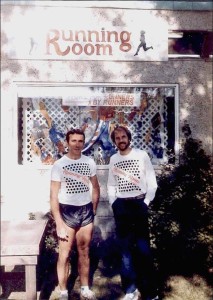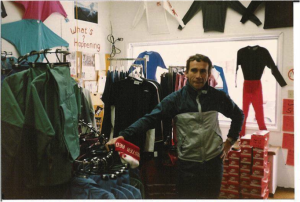Store Profile: The original Running Room


In July, the Running Room turned 30. Now expanded to almost all major towns and cities across Canada, with 114 stores in Canada and the U.S., started in literally a single room in Edmonton. John Stanton, the company’s founder, shared an old Edmonton home with a hairdressing salon where the two small businesses coexisted for the first eleven months before the company moved into the real estate the flagship store still holds on 109 Street.
Stanton, who now runs the business with his two sons, quit his job as an executive vice president with a major grocery chain to pursue what he describes as a passion for running. He did very little research but the timing was right and he filled a void in Edmonton’s running community.
Today, the store’s jackets are a common sight in communities across Canada and over 800,000 people have gone through the stores’ run club programs. Stanton was awarded the Order of Canada and road running has exploded in popularity, a small part of which can be attributed to his business making an intimidating sport a more inviting activity to outsiders.
We caught up with Stanton to talk about what it was like starting his business 30 years ago.
CR: You started off in a small room in an old home. What was that like?
JS: Yeah, it was 30 years ago July that we started in Edmonton. An old house, actually, and I shared with a hairdressing salon. The hairdresser had half of it and we actaully had the living room and kitchen of the house and that’s actually how we got the name the Running Room. The night before we were going to open, a buddy of mine came by and said ‘what are you going to call it?’ and I said ‘John’s Running Store.’ He said ‘that’s pretty lame. Can’t you come up with a better name?’ Well, it was one room in this whole house. What the heck were we going to call it, the Running Room? And that’s actaully how the name got coined.
The next day when we opened we put the Running Room sign up.
CR: What stands out as a memory from working in that one store?
JS: Well I just saw there was a need. I was this sort of born again runner. In my mid-30s, I’d gotten into running and what had happened was that there was a lot of places selling running shoes but you couldn’t get any good information.I had a background in retail because I’d been in the grocery business so I thought I’d open up this little retail store but we’ll do more than just sell running shoes. We’re going to teach people how to get into running.
I’d sort of gone through this epiphany of life and had sort of lost weight and quit smoking and got into running and started doing marathons and Ironmans and everybody asked ‘how did you do this?’ So I told them ‘well, anyone can do this with a little encouragement, knowledge and a little bit of coaching. So, when we opened that was it. We were selling running shoes and T-shirts and socks. That was sort of the apparel; we had a little bit of clothing but it was very limited. We were almost a T-shirt printing and running store when we first opened.
CR: How did you convince people they should get interested in running or that they should come in and buy things? This was long before the running community was the size it is now.

JS: Well it was a friend of mine, who I met through running, Jeff Galloway, came up and helped with the opening — I told him I was going to open a store so he said he’d come up and give me a hand — and when Jeff was there we did a little clinic and that’s kind of how we got started in this whole clinic idea. Originally it wasn’t even thought of as as a clinic. We were just going to meet once a week and take people for a run, but what we discovered, after about eight months when we moved to the south side location into the new store, I recognized that we’d sort of fallen into the trap of the local running clubs that I’d belonged to.
I belonged to the Edmonton Road Runners which was your typical running club but you had a to be a runner to go there. If you weren’t — if you were a beginner — you would be intimidated. What I was found when we first started and we had our Learn to Run and we got running and then we had to do a 10K and then and half-marathon and then we trained for the marathon, but in the process of about a year, all of a sudden, we had this great group of about 50 or 60 people running from the store but they were now like every other running club. Maybe they weren’t that hardcore, but they were confident runners and now we were intimidating those people who were like me and wanted to get running but didn’t know how to do it. That’s when my son, John Jr., was teaching in high school in those days. And he come home one night and had a lesson plan he was getting ready for the next day and I thought we could have that with running.
I didn’t invent walk-run, but I started walk-run because I could only run a set of light standards and then I had to walk, so I had done walk-run myself. This was about the time we were converting to metric and everything was in tens, which is where I came up with the 10 and ones.
CR: You mentioned opening a store without doing any research. That must have been intmidating.
JS: Exactly, I was in the grocery industry and I had a great career with great benefits as an executive vice president with a major grocery chain. People thought I’d lost my mind when I decided to start a running store, but I had confidence because I was passionate and when you’re passionate about something and you’re enjoying it it’s not really work. People say it was pretty courageous but it really wasn’t. You could call it dumb or you could call it blind confidence, but it really wasn’t. It was just a confidence that this was right and we were going to do it.
Running, when I was started, was pretty competitive. There was a go hard or go home mentality about it and that was just the era. Everybody lived fast and worked fast and running was a competitive side. I remember going to my first Vancouver marathon where if you didn’t break three hours you came home with a bag on your head because you were embarrassed. Heck, today if you break three hours you consider yourself an elite.
CR: What made you confident that you could do this?
JS: Oh, it took off. Within six months we had opened our second store. We were still in the old, little store in Edmonton when we opened the second store in Calgary. The races in Alberta, for example, people would come from Calgary to Edmonton and when they came they saw this little store — and we were busy right out of the gate. The timing was right and we were dumb enough to go ahead and just open a store. So we had people from Calgary saying we had to open a store in Calgary, so a friend of mine at the time was looking for some work. We set him up with our second store in Calgary and about every six months after that we were opening a store. After we opened in Calgary the next store was Vancouver.
This interview has been edited for length and clarity.


